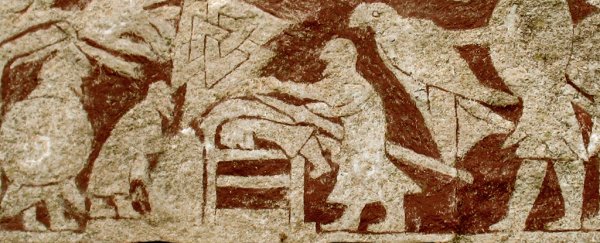Famed for their swift longboats and bloody incursions, Vikings have long been associated with brutal, over-the-top violence. Between the eighth and 11th centuries, these groups left their Nordic homelands to make their fortunes by trading and raiding across Europe.
Particularly infamous is the so-called "blood eagle", a gory ritual these warriors are said to have performed on their most hated enemies. The ritual allegedly involved carving the victim's back open and cutting their ribs away from their spine, before the lungs were pulled out through the resulting wounds.
The final fluttering of the lungs splayed out on the outspread ribs would supposedly resemble the movement of a bird's wings – hence the eagle in the name.
Depictions of the ritual have recently featured in the TV series Vikings and the video game Assassins Creed: Valhalla, as well as the 2019 Swedish horror film Midsommar.
For decades, researchers have dismissed the blood eagle as a legend.
No archaeological evidence of the ritual has ever been found, and the Vikings themselves kept no records, listing their achievements only in spoken poetry and sagas that were first written down centuries later. So the bloody rite has been rejected as improbable, resulting from repeated misunderstandings of complex poetry and a desire by Christian writers to paint their Nordic attackers as barbaric heathens.
However, our new study, takes an entirely new approach on the matter. Our team, made up of medical scientists and a historian, bypassed the long-standing question of "did the blood eagle ever really happen?", asking instead: "Could it have been done?" Our answer is a clear yes.
The anatomical practicalities
Previous scholarship on the blood eagle has only ever focused on the details of medieval textual accounts of the torture, with long-running debates concentrating on the exact terms used to describe the "cutting" or "carving" of the eagle into the victim's back. A widely-held position is that the whole phenomenon is a misunderstanding of some complicated poetry, not something that could actually have been attempted.
Using modern knowledge of anatomy and physiology, alongside painstaking reassessment of the nine medieval accounts of the ritual, we investigated what effect a blood eagle would have had on the human body. What we found was that the procedure itself would be difficult but far from impossible to perform, even with the technology of the time.
We suspect that a particular type of Viking spearhead could have been used as a makeshift tool to "unzip" the rib cage quickly from the back. Such a weapon might even be depicted on a stone monument found on the Swedish island of Gotland, where a scene carved into the stone depicts something that could have been a blood eagle or other execution.
However, we also realized that even if the ritual was carefully performed the victim would have died very quickly. Therefore any attempts to reshape the ribs into "wings" or remove the lungs would have been performed on a corpse. That last "fluttering" would not have happened.
While that might make the blood eagle sound even less likely to modern ears, we also demonstrate that while mutilating corpses and carrying out rituals on dead bodies was unusual, it was not totally out of character for the warrior elite of the Viking Age.
Retrieving lost honor
Drawing on archaeological and historical data, our research has shown that the blood eagle ritual fits with what we know about how the Viking-Age warrior elite behaved. They had no qualms about displaying the dead bodies of humans and animals in special rituals, including during spectacular executions.
Our study specifically examined so-called "deviant burials", like the skeleton of a well-dressed noblewoman who was beheaded in tenth-century Birka and subsequently buried with the remains of her head tucked between her arm and her torso, her missing jawbone (possibly destroyed during her decapitation) replaced by a pig's mandible. Warriors from this layer of society were also obsessed with their reputations, and were willing to go to extreme lengths to protect their image.
The blood eagle seems to have been a more extreme case of this sort of behavior conducted only in exceptional circumstances: on a captured prisoner of war who had earlier subjected the ritual-doer's father (or other male relative) to a shameful death.
In medieval sagas, some of these "trigger killings" include victims being thrown into a pit of snakes, being burned to death in a longhouse without the chance of a fair fight, and even having their guts torn out and nailed to a post. In the sagas, the blood eagle is depicted as a way for the victim's relatives to reclaim their lost honor.
Contrary to established wisdom, we therefore argue that the blood eagle could very well have taken place in the Viking Age. It was physically possible, in line with broader social habits regarding execution and the treatment of corpses, and reflected a cultural obsession with demonstrating your honor and prestige.
What's more, its spectacular brutality would have ensured that everybody who heard about it would be keen to tell the story in all its gory details - just as we're still telling them today. ![]()
Luke John Murphy, Postdoctoral Researcher in Archaeology, University of Iceland; Heidi Fuller, Senior Lecturer in Medical Science, Keele University, and Monte Gates, Senior Lecturer in Medicine and Neuroscience, Keele University.
This article is republished from The Conversation under a Creative Commons license. Read the original article.
